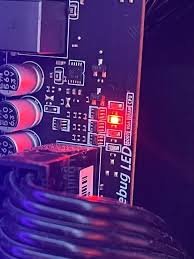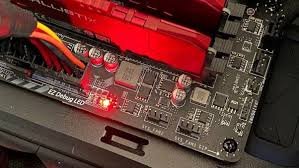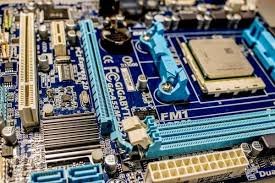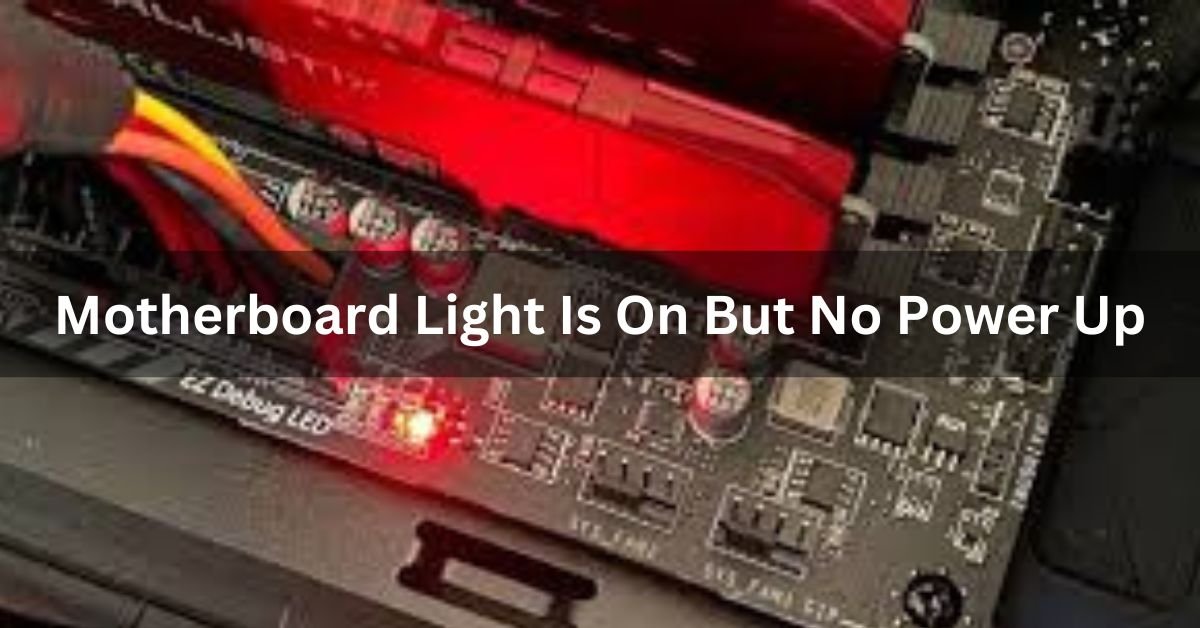One of the most frustrating situations for PC users is when the motherboard light is on, but the system fails to power up. This perplexing issue can stem from various underlying causes, ranging from simple power supply problems to more complex hardware failures.
The motherboard light is on, but the computer won’t turn on. This could indicate a power supply issue. Check connections and try a different outlet or power supply to troubleshoot.
In this guide, we’ll delve into the potential reasons behind this issue and explore troubleshooting steps to help you get your system up and running again.
Possible Causes:
1. Power Supply Issues:
A common culprit for a motherboard light being on but no power up is a malfunctioning power supply unit (PSU). If the PSU is not delivering sufficient power to the motherboard and other components, the system may fail to boot despite the presence of the motherboard light.

2. Motherboard Failure:
Another possibility is that the motherboard itself has encountered a failure. This could be due to a variety of factors, including overheating, physical damage, or component degradation over time.
3. RAM Issues:
Faulty or improperly seated RAM modules can also prevent a PC from powering up properly. If the RAM is not functioning correctly, the system may exhibit symptoms such as the motherboard light being on but no display on the monitor.
4. CPU Problems:
Issues with the CPU, such as overheating or incorrect installation, can also cause the system to fail to boot. If the CPU is not functioning properly, the motherboard may receive power but fail to initiate the boot process.
Troubleshooting Steps:
1. Checking Power Supply Connections:
Start by ensuring that all power supply connections are secure and properly seated. Inspect both the motherboard and PSU connectors to make sure there are no loose connections.
2. Testing the Power Supply Unit:
Use a multimeter or a PSU tester to check the output voltages of the power supply unit. Ensure that the voltages are within the acceptable range for your components. If the PSU is faulty, it may need to be replaced.
3. Inspecting the Motherboard:
Carefully inspect the motherboard for any signs of damage, such as burnt components or swollen capacitors. If any abnormalities are found, the motherboard may need to be replaced.
Read: Are Msi Motherboards Good – Ultimate Guide – 2024
4. Testing RAM Modules:
Remove and reseat the RAM modules one by one. If possible, test the system with known-good RAM modules to rule out any issues with the memory.
5. Checking CPU and Cooler:
Ensure that the CPU is properly seated in its socket and that the cooler is securely attached. Examine the CPU for any signs of damage, such as bent pins. Overheating can also cause the CPU to malfunction, so check that the cooler is functioning correctly.
Read: Should I Connect HDMI to GPU or Motherboard – Complete Guide!
Advanced Troubleshooting:
1. Testing with Spare Components:
If available, try replacing components such as the PSU, motherboard, RAM, and CPU with known-good spare parts to isolate the issue. This can help determine whether a specific component is causing the problem.
2. BIOS Reset:
Resetting the BIOS to its default settings can sometimes resolve compatibility issues or configuration errors that may be preventing the system from booting. Refer to your motherboard’s manual for instructions on how to perform a BIOS reset.
Read: Are Gigabyte Motherboards Good – Ultimate Guide – 2024
Motherboard light comes on but power button does nothing.
If the motherboard light comes on but pressing the power button does nothing, it could indicate issues with the power supply, wiring, or a faulty power button. Check connections and consider seeking technical assistance for diagnosis and repair.
Read: Can Motherboards Bottleneck – The Ultimate Guide of 2024!
Motherboard Light Is On But No Power Up Gaming?
If the motherboard light is on but your gaming PC won’t power up, it may signal issues with the power supply, hardware connections, or component failure. Check connections, test the power supply, and seek technical help for further troubleshooting.
Motherboard led not lighting up?
If your motherboard LED isn’t lighting up, check connections first. Make sure the power supply is connected properly. If it still doesn’t light, the LED might be faulty. Consult a technician for further assistance.
Why is my motherboard lighting up but not turning on?

If your motherboard lights up but doesn’t turn on, it could be a power supply issue. Check all power connections to ensure they’re secure. If it persists, the motherboard or CPU might be faulty. Seek professional help for diagnosis and repair.
Why is my motherboard not powering up?
If your motherboard isn’t powering up, check the power supply first. Ensure it’s properly connected and working. If that’s fine, there might be an issue with the motherboard itself or the CPU. Seek assistance from a technician for troubleshooting and repairs.
Why does my computer power light come on but nothing happens?
If your computer’s power light comes on but nothing happens, it could be due to a variety of issues. Check power connections, the power button, and try restarting. If the problem persists, it might be a hardware issue requiring professional assistance.
Will a dead motherboard still light up?
No, a dead motherboard won’t light up. When a motherboard is dead, it means it’s not working anymore. So, even if you plug it in, it won’t show any signs of life like lights or other indicators.
PC won’t turn on but motherboard light is on?
If your computer won’t turn on but the motherboard light is on, it could indicate a power supply issue or a component failure. Check connections, replace the power supply if needed, and troubleshoot hardware to resolve the problem.
Motherboard lights up but no power?
If the motherboard lights up but there’s no power, it suggests a potential problem with the power supply unit (PSU). Check PSU connections, replace if necessary, and ensure it’s supplying enough power to the motherboard and components for proper operation.
No power to motherboard?
If there’s no power reaching the motherboard, it could be due to a faulty power supply unit (PSU), loose connections, or a damaged motherboard. Check connections, try a different PSU if available, and troubleshoot to identify and resolve the issue.
How to fix motherboard no power?
To fix a motherboard with no power, try these steps:
- Check power supply connections.
- Test the power supply unit (PSU) with a known working one.
- Inspect for any damaged components or burnt areas on the motherboard.
- Replace the motherboard if necessary.
Can i use 3200mhz ram in 2933mhz motherboard?
Yes, you can use 3200MHz RAM in a 2933MHz motherboard. The RAM will likely run at the maximum speed supported by the motherboard, in this case, 2933MHz. It’s compatible, but won’t operate at its full potential speed.
Asus motherboard green light on but no power?
If the green light on your Asus motherboard is on but there’s no power, it could indicate issues with the power supply unit (PSU) or motherboard itself. Check connections, try a different PSU, and troubleshoot to identify and fix the problem.
Asus Motherboard Lights On But No Power?

If your Asus motherboard lights are on but there’s no power, it could indicate problems with the power supply, loose connections, or hardware issues. Check connections, try a different power outlet, or seek technical assistance for troubleshooting.
Pc Won’t Turn On But Power Light Is On?
If your PC won’t turn on but the power light is on, it suggests a potential issue with the power supply, hardware connections, or a malfunctioning component. Check connections and consider seeking technical support for further diagnosis and repair.
Will A Dead Motherboard Light Up?
No, a dead motherboard will not light up. If the motherboard light is not turning on, it could indicate a power supply issue, faulty connections, or a malfunctioning motherboard. Troubleshoot these areas to diagnose the problem.
Every cable plugged in, motherboard light is on, but no power to the PC as a whole.
When all cables are plugged in and the motherboard light is on, but there’s no power to the PC, it could indicate issues like a faulty power supply, loose connections, or hardware failure. Troubleshoot connections and consider seeking technical assistance for further diagnosis.
No Power to PC but green LED lights up on Motherboard?
If your PC has no power but the green LED lights up on the motherboard, it may suggest a faulty power supply or connection. Check connections, try a different power outlet, and seek technical support if needed.
Motherboard Light On When PC Is Off?
If the motherboard light is on when the PC is off, it could indicate standby power or a minor power leak. However, if the light persists when the PC is unplugged, it may suggest a hardware issue needing attention.
Why My PC Won’t Turn on But Motherboard Light Is on?
If your PC won’t turn on but the motherboard light is on, it might be due to issues like a faulty power supply, loose connections, or hardware failure. Check connections and consider seeking technical help for further diagnosis and repair.
Why Won’t My Computer Turn On?
If your computer won’t turn on, it could be due to various reasons such as a faulty power supply, loose connections, hardware failure, or software issues. Troubleshoot by checking connections and seeking technical assistance if needed.
My PC Not Turning On But Motherboard LED is?
If your PC isn’t turning on but the motherboard LED is lit, it might be due to issues like a faulty power supply, loose connections, or hardware problems. Check connections and consider seeking technical help for diagnosis and repair.
Read: Are SSDs compatible With All Motherboards – Complete Guide – 2024
Motherboard LEDs look OK but computer won’t turn on.
If your motherboard LEDs appear normal but your computer won’t turn on, it could signal issues with the power supply, hardware connections, or component failure.
Verify connections, test the power supply, and seek assistance for further troubleshooting if necessary.
Read: Can You Use ECC Ram In Non ECC Motherboard – Ultimate Guide – 2024
Motherboard light turns on but PC won’t boot?
If your motherboard light is on but your PC won’t boot, it may indicate problems with the power supply, hardware connections, or faulty components. Check connections, ensure the power supply is working, and seek professional assistance if needed.
Read: Can I Use 2400mhz RAM in 3200mhz Motherboard – Complete Guide!
PC won’t boot: no fans no power but led on mobo comes on?
If your PC won’t boot and there’s no fan or power, but the LED on the motherboard is on, it could be due to a faulty power supply, motherboard, or connection issue. Check connections and consider seeking technical support for further diagnosis.
Read: Is Any Motherboard Compatible With Any Case – Complete Guide – 2024
Motherboard Green Light On But No Power?
If your motherboard’s green light is on but there’s no power, it could be due to issues like a faulty power supply, loose connections, or hardware failure. Check connections, try a different power outlet, or seek professional help for troubleshooting.
Read: Can Motherboard Bottleneck CPU – Complete Guide – 2024
Why Are My Motherboard Lights On But No Power?
If your motherboard lights are on but there’s no power, it may be due to issues like a faulty power supply, loose connections, or hardware problems. Check connections, try a different power outlet, or seek technical assistance for further diagnosis.
Why Is My PC Not Turning On But My Motherboard Is?
If your PC won’t turn on but the motherboard light is on, it could be due to problems like a faulty power supply, loose connections, or hardware issues. Check connections, try a different power outlet, or seek professional assistance.
Why Is My Motherboard Light On But My Pc Is Off?
If your motherboard light is on but your PC won’t start, it could be due to issues like a faulty power supply, loose connections, or hardware failure. Check connections, try a different power outlet, and consider seeking technical support.
How To Check If Motherboard Is Receiving Power?

To check if your motherboard is getting power, ensure the power supply is connected and switched on. Look for indicator lights on the motherboard. If there’s no light or activity, try a different power outlet or power supply unit.
FAQs:
1. Why is the motherboard light on but my computer won’t power up?
This issue could be caused by various factors such as a faulty power supply unit (PSU), a loose connection between the PSU and the motherboard, or a malfunctioning motherboard component.
2. How can I determine if the power supply unit (PSU) is the culprit?
You can test the PSU by using a PSU tester or by substituting it with a known working PSU to see if the issue persists. If the computer powers up with the replacement PSU, then the original PSU might be defective.
3. Could a loose connection be the reason for the motherboard light being on but no power up?
Yes, a loose connection between the PSU and the motherboard, or other components such as the CPU or GPU, could prevent the computer from powering up despite the motherboard light being on. Double-check all connections to ensure they are secure.
4. What should I do if I suspect a malfunctioning motherboard component?
If you suspect a malfunctioning motherboard component, you can try reseating components such as the RAM modules, CPU, and GPU. If the issue persists, you may need to replace the faulty component or contact the manufacturer for further assistance.
5. Can a faulty RAM module cause this issue?
Yes, a faulty RAM module can prevent the computer from powering up properly. Try removing and reseating the RAM modules one at a time to see if the issue resolves. If not, try using known working RAM modules to isolate the problem.
6. Is there a chance that the CPU could be causing the problem?
Yes, a faulty or improperly seated CPU can prevent the computer from powering up. Check to ensure that the CPU is properly seated in its socket and that there is adequate thermal paste applied between the CPU and the heatsink.
7. What role does the BIOS play in this issue?
The BIOS (Basic Input/Output System) is responsible for initializing hardware components during the boot process. If the BIOS is corrupted or misconfigured, it could prevent the computer from booting up properly. Try resetting the BIOS to its default settings or updating it if possible.
8. Could a dead CMOS battery be the cause?
A dead CMOS battery can cause the BIOS settings to be lost, which might prevent the computer from booting up properly. Try replacing the CMOS battery with a new one to see if it resolves the issue.
9. Can a short circuit cause the motherboard light to come on but no power up?
Yes, a short circuit, either on the motherboard or within the connected components, could prevent the computer from powering up. Inspect the motherboard and components for any signs of physical damage or exposed wires.
10. What should I do if none of the above solutions work?
If none of the above solutions resolve the issue, the motherboard itself may be defective. Contact the manufacturer for warranty support or consider consulting a professional technician for further diagnosis and repair.
Conclusion:
In conclusion, when your computer’s motherboard light is on but it won’t power up, it’s frustrating. It might be due to power supply problems, motherboard failure, RAM issues, or CPU problems. By checking connections, testing components, and seeking help if needed, you can troubleshoot and fix the issue. Remember, simple steps can often solve complex problems and get your PC running again.
